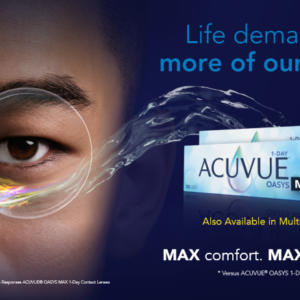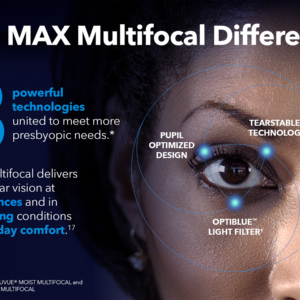peer reviewed
April 22, 2024
Fitting multifocals can be tough. From establishing “realistic expectations” to working through comfort and dryness issues, not to mention the delicate balancing act of obtaining sharp vision at the desired distance, it can feel like an impossible task for a clinician. With advancements in contact lens technology, we constantly seek innovations that enhance comfort, vision clarity, and ease of fitting.
Ultimately, both contact lens multifocal design AND material are critically important, especially in the presbyope population. As we know, coupling clear comfortable vision at every distance with an ocular surface that is more likely to break down due to the normal aging process is no easy challenge. In 2023, the TFOS Lifestyle report was published. It was found that across 34 studies, contact lens discomfort was the most frequently cited reason for discontinuation of contact lenses. Interestingly, specifically in studies that were focused on the presbyopic population, six of eight studies cited vision quality as the reason for dropout.1
Vision and comfort are inter-related when it comes to contact lens wear. In one retrospective analysis of five studies, the authors concluded that vision and comfort in contact lens wear are associated with one another, with visual ratings affecting comfort ratings of lenses, especially for the presbyopic population.2
So, what can you do if your patient is determined to make contacts continue to work for them? I have found that having a healthy knowledge of both lens materials and the optics of the lenses can be incredibly beneficial when your goal is to achieve multifocal clarity in as few sittings as possible.
Three-zone progressive design contact lenses offer wearers seamless vision correction for near, intermediate, and distance vision — all within a single lens. The design incorporates distinct zones optimized for different focal lengths, allowing for smooth transitions between vision distances.3
The three zones typically include:
- Near Vision Zone: Positioned in the center of the lens, this zone caters to close-up tasks such as reading or using a smartphone.
- Intermediate Vision Zone: Surrounding the near vision zone, this area addresses tasks at arm’s length, such as computer work or reading a menu.
- Distance Vision Zone: Outermost zone of the lens, providing clear vision for activities like driving or watching TV.
When it comes to the three-zone multifocals on the market today, its interesting to note the scientific process behind the lenses. Seven biometric factors are considered in the design, including pupil size, anterior chamber depth, high-order aberrations, axial length, corneal topography, diameter, residual accommodation across distance, and subjective refraction.4
I’ve found that the patient conversation is the most critical part of fitting multifocals. Although I’ve always believed patient selection and education to be the most important part of process, one multi-study analysis concluded that overall vision satisfaction at dispense is a strong indicator of multifocal success, with better vision satisfaction at dispense resulting in higher levels of intent to purchase.5 Once the lenses are on-eye, I make sure to assess the acuity and performance of the lenses in as “real-world” of a situation as is applicable to that patient. I still believe the pre-conversation is critical, but now pay more attention to ensuring that the patient is satisfied with their visual acuity before leaving the office.
In addition to three-zone progressive design, multifocal contact lenses come in various designs tailored to address specific visual needs:
- Aspheric Design: These lenses feature a gradual transition of power from the center to the periphery, providing a smooth shift between near and distance vision.
- Simultaneous Vision Design: Utilizing concentric rings or alternating zones of different powers, these lenses allow wearers to simultaneously focus on multiple distances.
- Spherical Design: Ideal for patients with low to moderate presbyopia, these lenses offer a simple yet effective solution for near and distance vision correction.
Each design has its unique advantages and considerations, depending on factors such as the patient’s visual demands, pupil size, and lifestyle preferences. As a new presbyope myself, I have found that my visual system is much more comfortable with a three- zone progressive.
Here are my top five tips for optimizing your multifocal lens fits in-office:
- Customized Material/Design Selection: Conduct a thorough assessment of the patient’s ocular health, lifestyle, and wearing preferences to determine the most suitable contact lens material AND design. Consider factors such as oxygen permeability, water content, and surface lubricity to minimize discomfort and maximize wear time.
- Education and Communication: Educate presbyopic patients about the importance of contact lens material in maintaining ocular health and comfort. Discuss the benefits of newer materials such as silicone hydrogels, which offer enhanced oxygen transmission and moisture retention, reducing the risk of dryness and irritation.
- Regular Follow-ups: Schedule regular follow-up appointments to monitor the patient’s comfort, visual acuity, and lens performance. Use this opportunity to address any concerns or issues related to contact lens material and make necessary adjustments to enhance wearer satisfaction.
- Hygiene and Compliance: Emphasize the importance of proper lens care, hygiene, and compliance to minimize the risk of complications and discomfort associated with contact lens wear. Provide detailed instructions on cleaning, disinfection, and replacement schedules to ensure optimal lens performance and ocular health.
- Trial and Error: Be prepared for a trial-and-error process when selecting contact lens materials for presbyopic patients. Encourage patients to provide feedback on their wearing experience and be willing to explore alternative materials or designs if initial choices prove unsatisfactory. (And maybe consider the earlier study discussed indicating that visual acuity at dispense matters — take that extra minute to dispense that small change in prescription, as you may find it makes all the difference!)
Conclusion
Three-zone progressive design contact lenses represent a significant advancement in multifocal contact lens technology, offering wearers seamless vision correction across various distances. By prioritizing contact lens material AND design selection, and addressing patient concerns proactively, we can provide our patients with enhanced visual clarity and comfort. By staying abreast of the latest research and advancements in multifocal contact lens designs, optometrists can continue to unlock new possibilities in vision care, improving the quality of life for our patients.
References
1 Lyndon Jones, Nathan Efron, Kalika Bandamwar, Melissa Barnett, Deborah S. Jacobs, Isabelle Jalbert, Heiko Pult, Michelle K. Rhee, Heather Sheardown, Joseph P. Shovlin, Ulli Stahl, Adriana Stanila, Jacqueline Tan, Silvia Tavazzi, Omur O. Ucakhan, Mark D.P. Willcox, Laura E. Downie,TFOS Lifestyle: Impact of contact lenses on the ocular surface,The Ocular Surface,Volume 29,2023,Pages 175-219,ISSN 1542-0124,https://doi.org/10.1016/j.jtos.2023.04.010 (https://www.sciencedirect.com/science/article/pii/S1542012423000368)
2 Diec, Jennie B.Optom.; Naduvilath, Thomas Ph.D.; Tilia, Daniel M.Optom., F.A.A.O.; Bakaraju, Ravi C. B.Optom., Ph.D., F.A.A.O.. The Relationship Between Vision and Comfort in Contact Lens Wear. Eye & Contact Lens: Science & Clinical Practice 47(5):p 271-276, May 2021. | DOI: 10.1097/ICL.0000000000000743
3 Bausch and Lomb Marketing Website for Infuse Lenses Infuse Marketing Website
4 Kingston AC, Cox IG. Predicting through-focus visual acuity with the eye’s natural aberrations. Optom Vis Sci. 2013;90(10):1111-1118.
5 Percy Lazon de la Jara, Anna Sulley, Pasquale Pepe, Karen Walsh, Michel Guillon, Multifocal contact lens success predictability, Contact Lens and Anterior Eye,Volume 47, Issue 2,2024,102105,ISSN 1367-0484,https://doi.org/10.1016/j.clae.2023.102105.





